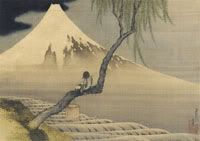 So I came across a few images in my Hieronymus Bosch book by Laurinda Dixon, and I found they tie nicely in with my recent obsession with evolutionary biology.
So I came across a few images in my Hieronymus Bosch book by Laurinda Dixon, and I found they tie nicely in with my recent obsession with evolutionary biology.Back in Bosch's golden years, the later 15 century, people believed in spontaneous generation, specifically life from water, mud, and dung. Aristotle hypothesized that the heat generated during the rotting of some substance created new organisms from the dissolution of particles during putrefaction-- organisms which later came to be regarded as deformed because of their asexual means of reproduction.

Hence, mer-creatures! These woodblocks are from the Hortus Sanitatis/Gart der Gesuntheit/Garden of Health, a pharmaceutical bestiary printed and translated a number of times during the 15 c.
Amongst others are the MONK FISH, described as having "a head like a monk...but the face is nosed like another fish and also his body." A very bookish creature. The aqueous unicorn is below him. And then there is the merknight. In Bosch's Garden of Earthly Delights, a merknight flirts with a siren-like creature who bends her tail backward and over her head, simulating the familiar alchemical symbol of the ouroboros. The serpent devouring its tail illustrates the cyclical essence of distillation--autocannibalism and auto-regeneration. Craziness.
 The Immense Journey talks about how Darwin's On the Origin of Species stimulated more materialisic philosophies (rather than mythological, or cosmo-magical) about the wellspring of earth. Urschleim, a protoplasmic semi-animate substance on the floor of the abyssal plain, was thought to be the development of the living out of the nonliving, from which arose complex life.
The Immense Journey talks about how Darwin's On the Origin of Species stimulated more materialisic philosophies (rather than mythological, or cosmo-magical) about the wellspring of earth. Urschleim, a protoplasmic semi-animate substance on the floor of the abyssal plain, was thought to be the development of the living out of the nonliving, from which arose complex life.Bathybius haeckelli is another interesting story.







0 comments:
Post a Comment